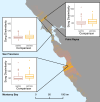Song and genetic divergence within a subspecies of white-crowned sparrow (Zonotrichia leucophrys nuttalli)
- PMID: 38809922
- PMCID: PMC11135742
- DOI: 10.1371/journal.pone.0304348
Song and genetic divergence within a subspecies of white-crowned sparrow (Zonotrichia leucophrys nuttalli)
Abstract
Animal culture evolves alongside genomes, and the two modes of inheritance-culture and genes-interact in myriad ways. For example, stable geographic variation in culture can act as a reproductive barrier, thereby facilitating genetic divergence between "cultural populations." White-crowned sparrows (Zonotrichia leucophrys) are a well-established model species for bird song learning and cultural evolution, as they have distinct, geographically discrete, and culturally transmitted song types (i.e., song dialects). In this study, we tested the hypothesis that divergence between culturally transmitted songs drives genetic divergence within Nuttall's white-crowned sparrows (Z. l. nuttalli). In accordance with sexual selection theory, we hypothesized that cultural divergence between mating signals both preceded and generated genetic divergence. We characterized the population structure and song variation in the subspecies and found two genetically differentiated populations whose boundary coincides with a major song boundary at Monterey Bay, California. We then conducted a song playback experiment that demonstrated males discriminate between songs based on their degree of divergence from their local dialect. These results support the idea that discrimination against non-local songs is driving genetic divergence between the northern and southern populations. Altogether, this study provides evidence that culturally transmitted bird songs can act as the foundation for speciation by sexual selection.
Copyright: © 2024 Luo et al. This is an open access article distributed under the terms of the Creative Commons Attribution License, which permits unrestricted use, distribution, and reproduction in any medium, provided the original author and source are credited.
Conflict of interest statement
The authors have declared that no competing interests exist.
Figures







Similar articles
-
Behavioural response to song and genetic divergence in two subspecies of white-crowned sparrows (Zonotrichia leucophrys).Mol Ecol. 2017 Jun;26(11):3011-3027. doi: 10.1111/mec.14002. Epub 2017 Jan 27. Mol Ecol. 2017. PMID: 28036146
-
Song ontogeny in Nuttall's white-crowned sparrows tutored with individual phrases.Behav Processes. 2019 Jun;163:24-31. doi: 10.1016/j.beproc.2018.02.010. Epub 2018 Feb 17. Behav Processes. 2019. PMID: 29462650 Free PMC article.
-
Seasonal plasticity of the song control system in wild Nuttall's white-crowned sparrows.J Neurobiol. 1998 Jan;34(1):69-82. doi: 10.1002/(sici)1097-4695(199801)34:1<69::aid-neu6>3.0.co;2-a. J Neurobiol. 1998. PMID: 9469619
-
Mechanisms of Cultural Evolution in the Songs of Wild Bird Populations.Front Psychol. 2021 Apr 26;12:643343. doi: 10.3389/fpsyg.2021.643343. eCollection 2021. Front Psychol. 2021. PMID: 33981272 Free PMC article. Review.
-
Bird song, ecology and speciation.Philos Trans R Soc Lond B Biol Sci. 2002 Apr 29;357(1420):493-503. doi: 10.1098/rstb.2001.1056. Philos Trans R Soc Lond B Biol Sci. 2002. PMID: 12028787 Free PMC article. Review.
References
-
- Servedio MR, Boughman JW. The Role of Sexual Selection in Local Adaptation and Speciation. Annu Rev Ecol Evol Syst. 2017;48:85–109.
MeSH terms
LinkOut - more resources
Full Text Sources

